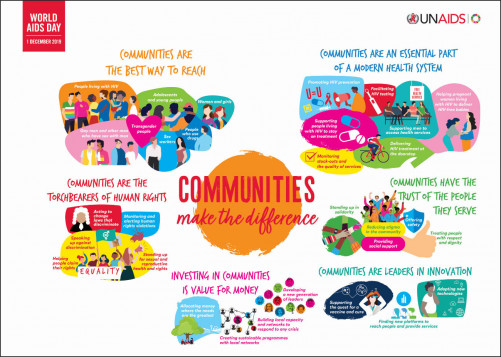Sunday, December 1, marks the 31st annual World AIDS Day (WAD). It commemorates those lost to the epidemic and encourages people across the globe to join in the fight against HIV/AIDS.
This year’s theme is “Communities Make the Difference,” according to the Joint United Nations Programme on HIV/AIDS (UNAIDS), which spearheads WAD.

Download graphics like these on UNAIDS.org.Courtesy of UNAIDS
Below, you can watch a statement by the group’s executive director, Winnie Byanyima, who says, in part: “Communities are the best hope for ending AIDS because they have fought against HIV right from the beginning.”
On its website, UNAIDS highlights the importance of communities in the fight against AIDS:
“Communities contribute to the AIDS response in many different ways. Their leadership and advocacy ensure that the response remains relevant and grounded, keeping people at the centre and leaving no one behind. Communities include peer educators, networks of people living with or affected by HIV, such as gay men and other men who have sex with men, people who inject drugs and sex workers, women and young people, counsellors, community health workers, door-to-door service providers, civil society organizations and grass-roots activists.
“World AIDS Day offers an important platform to highlight the role of communities at a time when reduced funding and a shrinking space for civil society are putting the sustainability of services and advocacy efforts in jeopardy. Greater mobilization of communities is urgently required to address the barriers that stop communities delivering services, including restrictions on registration and an absence of social contracting modalities. The strong advocacy role played by communities is needed more than ever to ensure that AIDS remains on the political agenda, that human rights are respected and that decision-makers and implementers are held accountable.”
You can visit the UNAIDS site to download sharable graphics, posters and reports. According to a UNAIDS fact sheet:
- In 2018, there were about 37.9 million people living with HIV; 1.7 million of them were younger than 15.
- 79% of all people living with HIV knew their HIV status.
- About 8.1 million people did not know that they were living with HIV.
- New HIV infections have been reduced by 40% since the peak of the epidemic in 1997.

Download graphics like these on UNAIDS.org.Courtesy of UNAIDS
Visit the POZ page devoted to World AIDS Day for a collection of stories and the #WAD2019 calendar. To learn more about HIV, including information about transmission, prevention and treatment, visit the POZ Basics.







Comments
Comments